AA/AAA NiMH Battery Chargers
Earth's Independent Source
for Unbiased NiMH Battery Charger Information
Last Update: 16 July 2007
http://nordicgroup.us/chargers
Questions, Comments,
Complaints, Corrections? Please e-mail to chargerexpert@nordicgroup.youess
(replace "youess" with "us")
Recent Additions:
Sanyo
NC-MQN05/GESMQN054
More
Chargers that Can Be Powered from a USB Port
Explanation of USB Current Limits
Introduction
There are often inquiries, on various
forums, as to which NiMH battery charger is the best choice. I have prepared a table of popular NiMH chargers
that meet certain minimum functionality, and that are reasonably priced.
This is a non-profit, non-commercial site; I don't sell anything.
See
http://batterydata.com for Information on the Pros and Cons of NiMH
versus Li-Ion Batteries for Digital Cameras
NiMH
Charger Comparison/What to Look for In a Charger
Criteria for Inclusion
I want to keep this page small, so I have
instituted the following criteria for inclusion of a charger:
-
Unbundled price of $60 or less
-
Minimum of 600mA current per AA
cell in fast charge mode
-
Settable to a charging current of 1000mA
or less per AA cell (even if a higher current option is available) in order
to maximize battery life
-
Individual charging circuits for
each cell (as opposed to requiring charging in pairs)
-
AC and DC power input possible,
preferably with car cord included
These criteria also define what you
should look for in a charger. Even if you buy a high-speed, high-current
charger, it should be capable of charging the batteries at moderate current when
you aren't in a hurry because high-speed, high current charging is very bad for
NiMH batteries in terms of how long the batteries will last. There is a
marketing advantage in advertising very short charging times, and most users
don't understand that such fast charging results in significantly shorter
battery life.
So far, I have found only eight chargers that meet these criteria. If you know of other chargers that I have missed, please
let me know.
Comparison Table
Green indicates good,
red indicates bad, regular text indicates
average.
|
|
|
|
 |
 |
|
 |
|
Model
(link to
retailer) |
Accupower
2010
Technical Details |
Accupower
AP-2020-1
Technical
Details |
iPower
FC-502 with International Adapter
Technical Details |
Maha MH-C401FS International Edition
Technical Details |
Maha
MH-C9000
Technical Details |
Suncocell SCR-A099
Technical Details |
Tenergy T60008
Technical Details |
Ultralast ULINOV2 |
Thumbnail
Photo of
Charger
(click fo
larger photo) |
 |
 |
 |
 |
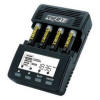 |
 |
 |
 |
| AC Input |
120V
(240V requires different AC adapter)
|
120V
(240V requires different AC adapter)
|
120V/240V |
120V/240V |
120V/240V |
120V/240V |
120V/240V |
120V/240V |
|
Flip Out AC Plug (no wall wart) |
No |
No |
No |
No |
No |
No |
Yes |
No |
12V DC
Car Cord |
Included |
Included |
Included |
Included |
Not Included |
Included |
Included |
Included |
| 5V USB Input |
Not Available |
Not Available |
Not Available |
Not Available |
Not Available |
Yes |
Yes |
Yes |
| Display |
LED |
LED |
LED |
LED |
LCD |
LCD |
LCD |
LCD |
Charge
Current |
600mA (4 AA)
600mA (4 AAA) |
700 mA (AA, AAA, C, and D)
30 mA (9V) |
600mA (4 AA) |
1000mA (4 AA) |
0.2A, 0.4A, 0.6A, 0.8A,
1.0A, 1.2A, 1.4A, 1.6A, 1.8A, 2.0A |
1000mA (4 AA) |
4 AA:
600mA (AC)
450mA (Car)
250mA (USB) |
? |
Slow
Charge |
Only |
Only |
Only |
Yes |
Yes |
Yes (use USB) |
Yes (use USB) |
Yes (use USB) |
Temperature
Sense |
? |
Yes |
Yes |
Yes |
Yes |
Yes |
Yes |
Yes |
Voltage
Sense |
Yes |
Yes |
Yes |
Yes |
Yes |
Yes |
Yes |
Yes |
Resistance
Sense |
? |
? |
? |
? |
? |
? |
? |
? |
| Individual Charging |
Yes |
Yes |
Yes |
Yes |
Yes |
Yes |
Yes |
Yes |
| 9V Capable |
No |
Yes |
Yes |
No |
No |
No |
No |
No |
| RAM
Capable |
Yes |
No |
No |
No |
No |
No |
No |
No |
|
Conditioning &
Rejuvenating
|
No |
Yes |
Yes |
No |
Yes |
Yes |
Yes |
Yes |
| Fan |
No |
No |
No |
No |
No |
No |
No |
? |
| Warranty |
2 years |
3 Years |
1 year |
Lifetime |
3 Years |
? |
? |
3 Years |
| Bundle |
No Bundles |
No Bundles |
8 AA-2100
2 Battery Holders
Battery Tester |
8 AA-2300
1
Battery Holders |
No Bundles |
4 AA-2500 |
12 AA-2600 |
4 AA-Hybrio
2100 |
| Bundled Price |
Not Available |
Not Available |
$65 |
$55 |
$60 |
$35 |
$35
($22 for charger only) |
$25 |
| Unbundled
Charger Estimated Cost1 |
$33 |
$49 |
$50 |
$38 |
$60 |
$27 |
$11 |
$15 |
|
1.
Subtract $2 per 2300-2700mAH AA cell, $1.50 per 2100-2200mAH AA cell, $1 per
2000mAH AA cell, $1 per AA 700-800mA cell, $0.50 per 4 battery holder, $1
per 8 battery holder, $2
per battery tester. |
Features
AC Input
All chargers can be powered from the AC mains. However not all chargers come
with a world-wide AC power supply that can be used from 120- 240V. You can
always buy a 12V universal adapter for the chargers that are not supplied with
one.
Flip Out AC Plug
Very few chargers that have the capability to use a car cord have a built-in
AC adapter. It's much more convenient to not have to lug around an external AC
adapter with the charger. The only model with this feature is the Tenergy T60008
from http://www.all-battery.com.
12V DC Input
Avoid any charger that doesn't have a DC car cord
included, as this feature is very useful, not only in vehicles, but also on
airplanes with EmPower or cigarette lighter outlets. You could use a 12VDC to 120VAC or 240VAC inverter, but this is a
hassle to carry around.
An EmPower to cigarette lighter socket adapter
can be found at
Magellan's. Radio shack may also carry them (they used to have them, but
I didn't see them on their on-line catalog). American Airlines uses regular
cigarette lighter adapters, and provides these outlets on some rows in coach. On
most airlines, EmPower sockets are only found in business class and first class,
and only on larger planes, see
http://www.rentcomputers.com/sosair.html. Be sure that your charger can
accept the 15V put out by EmPower sockets, but most can.

If you want to power several devices
at one, bring a cigarette lighter splitter. On one flight I was running my
notebook PC, and charging both my cell phone and my PDA, all at the same time. I
thought about bringing one of those 12 volt coffee makers on board, but thought
that the flight attendant might object.
USB Input Power
This feature lets you plug the charger into the USB port of a computer, and use
the power from the USB port (5V/0.5A minimum) to power the charger. Charge times will be
slower due to the limited power available, but you just need to carry a short
USB cable, rather than a bulky AC adapter (though in some cases the adapter is
built into the charger anyway).
The only chargers I could find that have USB input,
plus four individual charging circuits, are the Tenergy T60008 from
http://www.all-battery.com and the
Suncocell SCR-A099. Both are good deals though I have no idea as to
the quality of the batteries. The Tenergy T60008 is available unbundled for $22.
Another charger that can use USB input is a new charger from Ultralast that I
saw at Fry's that comes bundled with Hybrio batteries, but that I haven't yet seen on any web site, and don't know the
details (the packaging of the charger had very little information). I added it
to the table above, with the model number and UPC. Hopefully it will soon show
up on the Ultralast web site.
USB Input is Different than USB Output
Don't confuse the ability to power the charger
from a USB port with the chargers that have a USB output port (power only) to
which you can connect a device that can be charged from a USB port. For example,
the Lenmar MSC1USB Mach 1 Fusion has a USB output port which can be used
simultaneously with the regular charger (which can charge most Li-Ion batteries
as well as NiMH AA cells), but cannot be powered from a USB port.
|
USB Current Limits
"If every USB socket is attached to a unique USB
port, there would be no problem. But that's not the case, and though
you many not be able to tell by looking at the connectors, they may be
daisy-chained, sharing power and bandwidth."
There are
four errors in the above statement which was posted in
rec.photo.digital
by one of the main posters of incorrect information to that forum. First, every
USB socket in a computer is connected to a unique USB port. Second, the
USB connectors are not daisy chained, either for power or data. Third,
the USB ports in a computer do not share USB bandwidth (each one can
operate at the full 480 Mb/s). Fourth, the USB ports in a computer do not
share power (each port is capable of supplying a minimum of 500mA).
I have a lot of
experience with USB design, including on the power side of it, so
hopefully I can clear up the confusion, though I doubt that many people
are as confused as the person that wrote the statement above.
-
USB uses a multi-level star
topology, and every USB socket is connected to a unique USB port on
the USB root port hub in the computer.
Each USB port on a computer can supply a minimum of
500mA; that 500mA isn't shared among all the ports. Only if
you plug in an unpowered USB hub into a powered USB port is the
power on the ports from the hub shared among the hub ports.
-
While the USB specification guarantees only 500mA
per USB port, this is a minimum, the port doesn't shut
down at 501ma! In most cases a USB port will supply 750-1000mA before the
over-current protection circuit shuts it down, especially if not all USB ports
on the system are used (there are no guarantees, so don't run out
and design a device that draws 1000mA). For example, the
National
Semiconductor LM3544, a widely used over-current protector,
limits the current per port to 1.0A (typical) even though the total
current limit for four ports is 2.0 amps (to protect the power
supply). What this means is that if you don't use all the USB ports,
the ones you do use will be able to supply more than 500mA of
current. This is why external notebook hard
disk drives will usually work without using the external power adapter, or Y
adapter (two USB ports power the device), even though they
draw more than 500mA. Obviously you shouldn't try to connect four external
DVD±R/W drives to one computer, without using the
external power supplies for the drives. While you shouldn't design a
USB peripheral that exceeds the guaranteed 500mA, the reality is
that the limit is often exceeded without any consequences.
-
HID class (human input device) peripherals such as mice and
keyboards obviously require very little current (15-25 mA), and powered
devices such as printers and scanners require no current, leaving
more current available for higher power, USB powered devices.
These HID devices can request only 100mA power when they are plugged
in and enumerated.
-
Some computers have designated high-power USB ports. For example, I
helped design a Compaq Tablet PC (TC1000/TC1100) with such a port. Next to one of
the USB ports is a keying hole. Compaq sells an external CD/DVD
drive that plugs into this port, and the connector has a pin that
goes into only the USB port with the key. The reason for this design
was to allow portable use of the external drive without the need for
an external power supply. This USB port guaranteed 1.5A of current
(continuous). Any USB device could use this port,
but the CD/DVD drive had to be plugged into this port. This saved
precious connector space, eliminating the need for a seperate custom
connector.
-
Some external drives have a
cable that plugs into two USB ports in order to increase the
guaranteed available current. On an external DVD±R/W
drive (which will typically draw 800-900mA when writing), you may
find that you need power from two ports in order to burn discs, but
power from only one port to read discs, but it will often work fine
from a single port.
-
You
can get into trouble is if the combined current from all USB devices
exceeds 2.0A (on a computer with four USB ports). For example, if
you plug in a 1A USB device into one port, and then try to plug
three 500mA devices into the three other ports, you're at 2.5A,
which is over the total current limit of 2.0A.
-
Underwriters Laboratories requires that a USB port shut down if more
than 5A of current is attempted to be drawn from it. This is similar
to the UL requirement that PS/2 keyboard and mouse ports have
current limit protection (typically a picofuse soldered onto the
motherboard). Remember those devices that used to tap off the PS/2
connector for power? This was a bad idea because if you blew the
fuse you destroyed the PS/2 port unless you were willing to replace
the soldered-in picofuse. The USB over-current devices automatically
reset once the load is removed.
-
On the few PDA type devices
that have a USB host port (as opposed to just being a target USB
device) you may run into a real 500mA limit. Such devices are few
and far between. Toshiba used to have a PDA with a true USB host
port, but I don't know of any other such devices.
-
There is an exception to the
500mA requirement, in that battery powered devices may supply only
100mA per port. This exception is taken advantage of in small
systems such as PDAs, but never on notebooks and laptops, even when
they switch from AC to battery power. Technically a notebook or
laptop operating on battery power could reduce the available current
from 500mA to 100mA when external power is disconnected, because it
could then be legally considered a battery powered hub. In practice
this is never done because it would cause any high power USB devices
to instantly disconnect if power were removed, even in the event of
a power failure. You can easily verify this by plugging a high power
USB device into your laptop while it is on battery power.
-
USB Bandwidth is not
shared among ports. Every USB port of the root port hub in the
computer is capable of the full USB bandwidth (whether the computer
can keep up with four or more USB 2.0 ports operating at 480Mb/s is
another issue entirely). The only time bandwidth is shared is if a
second hub is connected to the root port hub. Some notebook computer
docking stations have a powered hub in the dock, which connects to
the root port hub in the notebook. In this case the bandwidth is
shared.
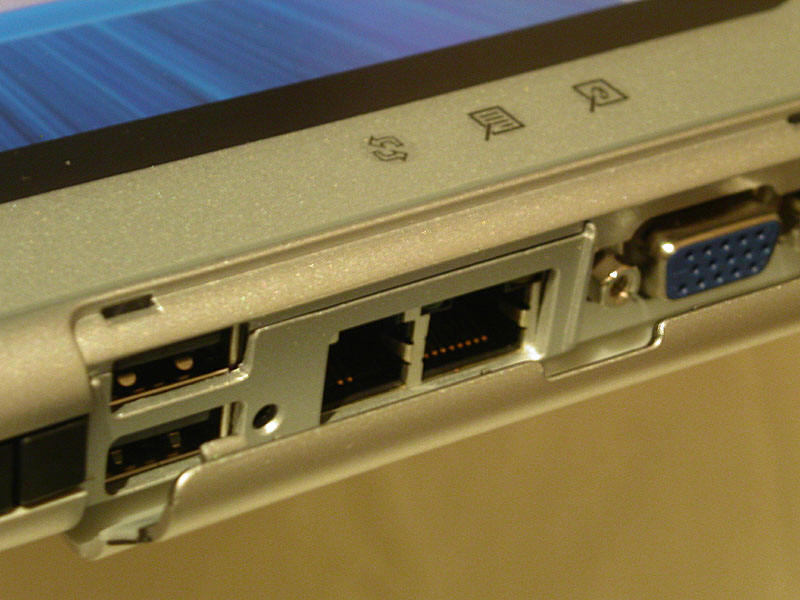
Compaq TC1000 High Power
USB Port Guarantees Sufficient Current for a DVD Drive (1.5A continuous, 2.25A
peak). Note
the small hole next
to the
lower USB connector. This is for an external Multibay enclosure.
The Multibay has a special USB
plug with a key that fits into that hole to prevent it from being plugged into
the 500mA current USB ports. This port can also
be used as
a standard USB port. A lot of
bibimbap and soju was consumed during the design phase of this project at LG in
Korea.
For more information, download the USB
specification from
http://www.usb.org/developers/docs/usb_20_040907.zip , unzip the files,
open usb_20.pdf, and look at section 7.2.
|
How a NiMH Charger works off of USB Power or 12V
Power
Inside the charger is a DC-DC buck converter with an
input range of about 4.5 to15 volts. For chargers that charge cells
individually, the output of the DC-DC converter is about 1.8 volts, with the
current being variable, depending on the input current. For a USB port at 500mA,
the total current available is 5V*500mA/1.8V=1389mA. Since the DC to DC
converter is not 100% efficient, and since the charger controller circuitry uses
a small amount of current, the total current available to charge the batteries
is 1000-1200mA so the current per cell is 250-300mA in USB
mode (this is where the 250mA charger current on the Tenergy T60008 comes from).
To charge four completely discharged 2500 mAH cells would take up to ten hours,
but of course you're rarely, if ever, charging cells that are completely
discharged.
When powered from a 12 volt source, the charger
could actually charge at a higher current than specified, but the charger has
current limiting built into the DC input circuitry to not draw too much current
from a USB port, and the same circuitry limits the current from the 12 volt
source. They would have had to have a second DC input jack to differentiate
between 5 volts (USB) and 12-14 volts (car), if they wanted to charge at a
higher rate from 12-14 volts.
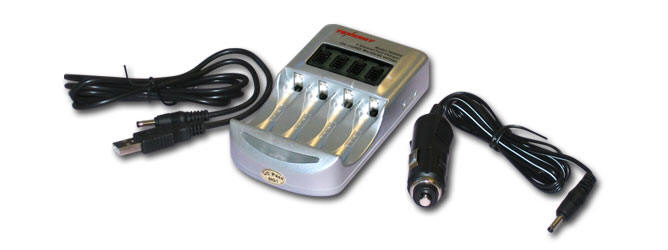
Tenergy T60008 From
Allbattery.com shown with Car Cord and USB Cord (AC is a flip out plug)
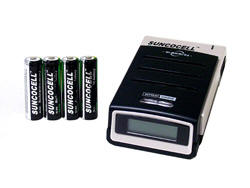
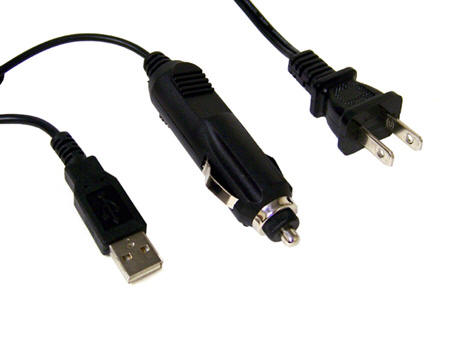
Suncocell SCR-A099 shown with its three options for
powering
What About Li-Ion USB Chargers?
Many small Li-Ion powered devices such as cell phones and PDAs can be charged
directly from the USB port. These devices use a single 3.7V Li-Ion cell, so 5
volts is sufficient for charging. Smaller digital cameras (sub-compact) use
single cell Li-Ion batteries as well, but USB charging is not that common
(though there are some cameras that use it). Larger digital cameras (compact and
D-SLR) use two cell 7.4V Li-Ion cells, so USB charging is impractical because it
would require a DC-DC boost converter. These converters are relatively
efficient, but with the minimum guaranteed current of 500mA, even small losses
are unacceptable
Display
An LCD display is a little nicer than various LEDs, but this should not be a
deciding factor.
Charge Current
Do not get carried away with charge current. If you can accept lower charge
currents, and longer charge times, you will extend the useful life of
your batteries. The higher rate chargers,
i.e. "15 minute, 1/2 hour" or "1 hour" chargers," cause the batteries to get very hot, which
shortens their life. For digital cameras, most people use two sets of batteries,
charging one set while using the other, hence a four hour charge time for a
2400mAH cell is not an issue.
However there's a flip side to the charging
current equation, in that higher current charging tends to use more of the
available capacity of the cell than low current charging. Buchman writes:
"NiMH batteries which use the NDV method or the
thermal cut-off control tend to deliver higher capacities than those charged by
less aggressive methods. The gain is approximately 6 percent on a good battery.
This capacity increase is due to the brief overcharge to which the battery is
exposed. The negative aspect is a shorter cycle life. Rather than expecting 350
to 400 service cycles, this pack may be exhausted with 300 cycles."
What has complicated the issue of charge rate is
the increasing capacity of cells without any increase in their physical size. It
is necessary for a high capacity cell (i.e. 2700mAH) to dissipate much more heat
during a 0.5C charge cycle than it was for an 1800 mAH cell to dissipate during
a 0.5C charge cycle. So while a 0.5C charge rate was desirable on a
lower-capacity battery, it can cause excessive heating in a high capacity
battery. This is why some fast chargers include cooling fans, they are trying to
use forced air cooling to transfer more heat out of the battery. It's very
similar to the heat transfer issue that affects semiconductors. As more and more
transistors are packed into the same size (or smaller) dies, it becomes
increasingly difficult to transfer the heat out of the die. While the Pentium
CPU had only a small heat sink, as the power of the CPUs increased, it became
necessary to device elaborate heat sinks and to add cooling fans.
With NiMH batteries, there's a fine line between
too low of a charging current and too high of a charging current. Too low, and
it may not detect end-of-charge correctly. Too high, and it may heat the
batteries to the point where it reduces their useful life. NiMH batteries are now
pretty inexpensive (at least AA cells). So reducing the useful life of your
batteries, in order to have faster charge times and higher capacity, may be a trade-off that you are
willing to make. The best advice, at least with digital cameras, is to try to
avoid AA powered cameras, and stick to Li-Ion powered cameras, but there are a
couple of very good digital cameras that use AA batteries.
Slow Charge Mode
On high current chargers (>1000mA or so), a very useful feature is a
selectable charge rate to lower the charge current when high-speed charging is
not needed. As explained above, very high charge currents have the downside of
significantly shortening a battery's useful life.
The Maha MH-C401FS has a manually selectable slow charge mode (300mA charge
current per cell). For overnight charging, this is ideal.
The Maha MH-C9000 has a wide
variety of charge currents available.
The Tenergy T60008 doesn't have selectable charge
currents per-se, but if used with a USB port as the power source it charges at
only 250mA when charging 4 AA cells. This actually can be too low, but since the
USB port can only supply a limited amount of current, you have to live with it
if you want USB charging.
Temperature Sense
All chargers listed monitor the temperature of the batteries, though as I found
out with the Panasonic BQ-830, such temperature sensing may not actually prevent
overheating. Some chargers will not only detect over-temperature, but
track temperature changes over time as another indicator of when the charge is
complete.
Voltage
Sense
All chargers listed monitor the voltage of the batteries to determine when
charging is complete. NiMH batteries reach a voltage plateau which the
microcontroller in the charger identifies in order to know when to stop
charging.
Resistance
Sense
At least some of the chargers listed monitor the internal resistance of the
batteries. This is useful for two reasons. First, it is another indicator of
charge condition. Second, it enables the charger to recognize when a
non-rechargeable battery is placed into the charger (alkaline batteries have a high internal resistance, while NiMH and NiCad batteries have a very low
internal resistance).
Individual Cell Charging
All chargers listed provide individual charging. This is a very important
feature, as it allows each battery to be fully charged. Also, there are many devices that use one or three batteries, and it is a
hassle to charge odd numbers of cells on chargers without individual charging
circuits. The very low end NiMH chargers usually require charging in pairs, as
it is a bit less expensive to manufacture a charger with only two charging
circuits, as opposed to four charging circuits.
9V Capable
Some chargers can charge NiMH 9V batteries (be careful, as NiMH 9V batteries are
rated at 9.6V or 8.4V, not 9V).
Rechargeable Alkaline-Manganese Capable
Only one charger in my list is capable of charging rechargeable alkaline-manganese
batteries, the Accupower 2010.
Conditioning/Rejuvenating
Sounds like something for your hair, but it's not. This function does an
automatic discharge/recharge, which may increase the capacity of the battery.
There is little evidence to support this concept (it is a real concern on Li-Ion
batteries, but not on NiMH batteries). In any case, you could always do this
manually by discharging the battery in a device such as a flashlight. Still it
may be a useful feature for the battery "hobbyist."
Fan
Most of these chargers are convection cooled. This works fine, unless you
happen to get a bad cell with a very low internal resistance. The first BQ-830
charger I had was returned to Costco after it melted while trying to charge a
defective Lenmar 2000 mAH AA cell. Even a fan-cooled unit might not have
prevented such a thing from happening, but clearly the temperature sensing in
the BQ-830 left something to be desired.
The very high rate chargers should include a fan.
If the charger current for an AA battery is more than 3000mA, do not buy the
charger unless it has a fan.
Warranty
Warranties range from 90 days to lifetime. There
are many poor quality chargers on the market, and chargers that are not
well-designed often fail due to excessive heat. The lifetime warranty on the
Maha MH-C401FS may turn out to be a useful feature.
Bundle
It is common for manufacturers and retailers to bundle a bunch of batteries
with the charger.
Price
I have chosen to limit this page to chargers which, when bundled with a minimum
of 4AA cells (minimum of 2200mAH), have a street price of less than $75. I have
also calculated an unbundled price on the charger
value alone (based on conservative allowance for batteries, holders, and
battery tester); maximum of $50 for the charger value alone.
NiMH
Charger Recommendations

Best Overall--Maha
MH-C401FS

Selectable Charge Rate and Best Warranty
The option for a lower charge current is a very good feature of the
MH-C401FS. Most times you probably won't need a high speed charge, and the lower
current charge lengthens the life of the batteries since they don't get as hot.
While Maha chargers are not the lowest priced, the
warranty on this specific charger appears to be very good, even though I'm
always leery of so-called "lifetime warranties." Battery chargers are
one electronic device that may actually fail prematurely, due to the amount of
heat generated. The terms of the lifetime warranty are not disclosed on the Maha
web site.

Most Versatile & Most Convenient--Tenergy
T60008

A flip out AC plug (rather than a bulky wall
wart) and the ability to use a USB port as a power source make this charger a
good choice for travelers. The only charger with these two features (that also
has individual charging circuits).

Best for the Battery Hobbyist--Maha
MH-C9000

This full featured charger allows the user to
condition, rejuvenate, and do capacity tests of batteries. Unlike the MH-C401FS,
it does not come with a lifetime warranty. It also does not come with a DC power
cord (extra cost option). However it's better than the LaCrosse Technology BC-900
because at least a car cord is available.
This charger has one issue. Early models
suggested charging at not less than 0.33C, which would be 700mA for 2700mAH AA
cells. However there was a problem with the charger detecting end-of-charge at
this current level, so Maha changed the recommendation to 0.5C which is 1350mA
for 2700mAH AA cells. This higher current will have a slight effect on the
longevity of the batteries (it's not stupid-high like 2000 mA, but it's still a
tad high). Even Maha states in the manual, "Typically speaking, slower
charging rate will yield better battery performance but requires longer time.
Faster charging rate may not charge as fully and battery temperature can be
higher." One poster to
rec.photo.digital
poster wrote, "The newly revised Maha C-9000
(says 0G0GB01 on the label - a few months ago) manual has been revised to now
say to charge at 0.5 to 1.0 C, in order to detect delta V cutoff more reliably.
Actually, I'm not certain it is still delta V, but the early two versions
(0FAB01 or 0FAB02) didn't always do all that well on shutoff termination at
lower currents. Both the charger and the recommendation were changed for this
problem. I believe Maha will replace older versions."
Maha has made many changes to this charger since
its release, and according to some forums they will replace older models.
According to one individual, "...they revised the chargers termination
procedure, which is now version 0G0B01 on the rear label (my typo before). Maha
has been replacing older units 0FAB01 or 0FAB02. Apparently NiMh cells don't
have much of a delta V peak at low currents, which risks overcharging if missed.
It can still be set as low as 200 mah, and they left the default charge rate at
1000 mah, unless changed, but the printed recommendation now is 0.5C to 1.0C.
Another related change is that it used to charge up to about 20000 mah unless
terminated, and now it shuts off after 4000 mah."
Note the wide spacing between the batteries. This
is because temperature monitoring for each cell is more accurate when the cells
are not packed close together.
Other NiMH
Chargers
Sanyo NC-MQH01 Quick-Charge-Compact
AC-Only Plug-In Charger
Note: The instructions included with the charger
package from Costco are incorrect. This charger does charge cells individually.
It is dual rate as well. See the actual instructions at
http://www.sanyo.com/batteries/pdfs/MQH01_manual.pdf.
The charge current for regular rate is 900mA for
four AA cells, 900mA or 2000mA for two AA cells (depends on which slots you
insert the batteries into).
This charger charges batteries individually, but cannot be
used with a DC car cord (of course an inverter is always an option, but it's a
hassle). It is a very good deal (Costco), at $20 with
eight high-quality, high capacity, Sanyo batteries (six 2500 mAH AA cells, and
two 900 mAH AAA cells). The batteries alone would cost $18 from Thomas
Distributing. It also has a real battery tester, something that is not normally
found on chargers. It does
work at 100-240V. It is an extremely sophisticated charger, with individual
charging control, timer control, peak voltage control, minus delta voltage
detection, temperature control/protection, alkaline battery detection, and short
circuited cells detection.
Unfortunately, Costco no longer carriers this
charger. They have a more expensive, and less capable, Duracell labeled charger.
This is the situation where a company decided to produce a very capable product,
then suddenly realized that they couldn't charge more money for it because most
of the target market had absolutely no idea why they should pay a little more,
versus the el-cheapo alternative.
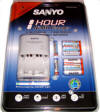
GE/Sanyo
NC-MQN05 Quick-Charge-Compact
AC-Only Plug-In Charger
Sanyo has
introduced a charger with Eneloop batteries, as model NC-MQN05, also known as
GESMQN054. This model does not have a switch for NiMH versus NiCad
charging, which is no big deal. Unfortunately they dropped the internal battery
tester which was a really nice feature on the NC-MQH01. This charger has a
sliding cover. It is very light and compact. This is a very low rate charger,
300mA for AA, and 150mA for AAA. The manual is available at
http://www.eneloopusa.com/pdf/4_Position_Charger_IS.pdf. The manual has
incorrect nomenclature, referring to the output current in mAh rather than mA.
Still, it might be a good charger for traveling, as long as overnight charging
is acceptable. It comes with four AA Sanyo Eneloop batteries.
It's $30 at
Circuit City or
J&R.
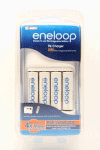
LaCrosse Technology BC-900
This wa probably the most full featured compact charger on the market until
the release of the Maha MH-C9000. The
cheapest place to buy this is at
Amazon ($35), since they do not charge for shipping
(Thomas
Distributing charges $43, plus shipping).
It comes with four AA, and four AAA rechargeable batteries; four C- and four D-size battery adapters; and a
carrying bag.
Even though this charger uses an AC
adapter type supply, there is no DC car cord available. The unit requires 4 amps
at 3 volts, which is quite strange, though it is by design. No one that I could
find manufactures a DC-DC converter that provided 12 volts at 4 amps. If you are
handy with building electronic projects then you can construct your own DC
adapter fairly easily, by using a DC-DC converter, a suitable enclosure, and a
fused cigarette lighter plug, but it will likely cost you about $30 to build.
See
http://www.mouser.com/search/ProductDetail.aspx?R=SIL15C-12SADJ-Vvirtualkey54020000virtualkey826-SIL15C-12SADJ-V. You could also simply use a small inverter
for in-car use; 75 watts is more than enough.
There seem to be many complaints
about this charger's reliability on the various forums.
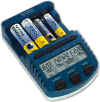

Electrify Triton--The Charger to End All Chargers (charges all kinds
of batteries including Lithium Polymer)
The ultimate charger is the GPMM 3150
Electrifly Triton DC Computerized, Charger, Discharger, and Cycler.
Designed primarily for radio-controlled toys, this
unit will charge 1-24 NiCad or NiMH batteries, 1-4 Li-Ion or Li-Po batteries,
and 6V, 12V, and 24V lead acid batteries. It requires connection to a car
battery, or to a hefty DC power supply (13 amps). $128 without a DC power
supply. You'll be at over $150 by the time you buy a power supply and pay for
shipping. You actually can use a much lower amperage power supply if you are not
trying to charge a lot of batteries at a fast charge rate. This charger is
capable of charging at 28.8 volts, 5 amps, which would be 144 watts, which would
require an input current of 12 amps at 12 volts if there were no losses, hence
the 13 amp input requirement (156 watts). If you are charging a 14.4 volt pack at a 3AH
rate, then a 5 amp 12 volt (60 watt) power supply is sufficient. The charger will accept
10.5-15 volts input.
Click
Images for Details
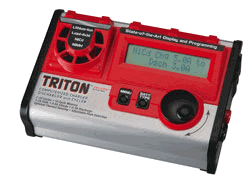 |
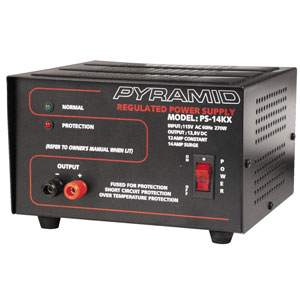 |
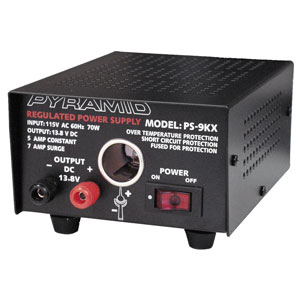
|
|
Electrifly Triton $128
Manual
|
Pyramid PS-14KX 13.8 volt
12 amp power supply (153 watts)
$38
|
Pyramid PS-9KX 13.8 volt 5
amp power supply (69 watts)
$21
|
Universal
Chargers for NiMH and Li-Ion Battery Packs
If you're going crazy with chargers for cell phones, camcorders, PDAs, GPSes, digital
cameras, etc., you may want to consider a universal charger that can charge both
AA cells and most Li-Ion batteries.
Lenmar MSC1USB Mach 1 Fusion All-In-One Speed Charger
with USB Output
This charger can charge nearly every
Li-Ion camcorder or digital camera battery, as well as NiMH AA and AAA cells. It
has a USB connector for using USB charging cords for cell phones, PDAs, and
other devices that can be charged via USB (simultaneously with charging
batteries on the adapter plate). It can be powered by AC, or by an
included car cord. This charger will end the excuses regarding Li-Ion batteries!
There is also a version without the USB output (MSC1U). Buy from Digitally
Unique for $53. It comes with adapter plates for the most common
batteries, and you can buy plates
for most other Li-Ion batteries. It comes with a coupon for one free adapter
plate (or download coupon).
The USB output is very useful
especially because it works simultaneously with charging a Li-Ion battery (or
NiMH batteries) on an adapter plate. One problem with universal chargers such as
the Maha MH-C777PLUS-II (below) is that while it can be
used to charge a cell phone battery, the battery must be outside the phone, and
it is limited to one battery at a time.
If you are having a
hard time finding a replacement charger for a less popular brand of camera or
camcorder, you will want to look at this charger and the available plates.
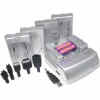
Maha MH-C777PLUS-II Universal LCD Charger / Analyzer / Conditioner
This charger will also charge virtually any battery, but it requires a little
more work on the part of the user when charging proprietary Li-Ion packs, since
you need to align moveable pins with the contacts on the pack, as well as
figuring out which contacts to connect to. It can charger virtually any Li-Ion
pack, including cellular phone packs (removed from the phone). $75 from Thomas
Distributing. Buy battery
holders for NiMH and NiCad batteries. Buy some additional clip leads to
connectorize the battery holders see http://thomas-distributing.com/maha-mh-c777-faq.htm.

The NiMH versus Li-Ion Debate
This is an endlessly discussed issue
on the digital camera Usenet groups and other forums. Manufacturers of cameras, camcorders, cell
phones, PDAs, notebook computers, high end bicycle lights, etc., moved from NiMH
to Lithium-Ion batteries for a number of very good reasons, but there
are also some advantages to the older technology, at least when the NiMH
batteries were AA or AAA size cells. Please visit
http://batterydata.com for more
information.
Trickle Charging Large Numbers of NiMH
Batteries at Very Low Cost
To keep large numbers of batteries topped
off, without damaging them, you can build a charger that continuously supplies a
very low charge current (10mA.or so to the pack) I do this because it enables me
to keep fresh batteries, ready to use, available for my kid's toys, FRS radios,
etc. It also prevents the batteries from going bad, which will happen if you let
them sit around for long periods of time uncharged. You could not really charge
a fully discharged battery with this charger (it would take hundreds of hours),
but it's fine for keeping quantities of batteries ready to use, without damaging
them.
The cost of such a charger is very low, it's just
some diodes, resistors, battery holders, and a cheap regulated AC adapter that
can put out around 7.5V.
Theory
For four batteries, you need to supply a minimum of 6.6V (1.65 x 4) to each
pack. Since the packs need to be isolated from each other (you cannot charge
NiMH batteries in parallel), a diode is used on each pack, which also drops the
voltage down by 0.7V. So you should use a 7.5V, regulated, AC adapter. The
voltage doesn't have to be precise, but it should be somewhere between 6.5 and
7.5V.
Empirical Measurements
Using this charger, I measured the current flow
through a set of four fully charged Sanyo 1800mAH AA cells (1.43V per cell, no
load), and it was
about 10mA. Measuring the voltage of the four-pack, when not hooked to the
charger it was 5.72V, when hooked to the charger it was 5.73V. The no-load
voltage at the battery holder terminals was when open circuited it was 7.4V.
How to Build
- Buy battery holders that hold four cells in
series (click for links): 4
AAA, 4
AA, 4
C, 4
D
- Attach a
connector
to each pack. The
connector
I specify is convenient because it is two molded connectors on a cable, you
simply cut the cable apart, and splice each end to either the battery pack.
- Install a diode
between the +7.5 and the positive lead of the mating connector. This isolates
each pack.
- Install a resistor
between the -7.5 and the negative lead of the mating connector. This
limits the current to around 60mA per pack, but the actual
current is much less because of the pack's internal resistance, and because
the voltage of the pack is not zero.
- The advantage of using a
connector on each pack is that
you could then plug each battery pack into a regular charger such as the
Maha MH-C777 PLUS
and be able to fast charge a whole pack, then move the pack to the trickle
charger. You could also make a little harness for the
Maha MH-C777 PLUS that put three 4-packs in series, since the
Maha MH-C777 PLUS
can charge twelve cells at once.
- Buy a
PST-1200MF AC adapter ($7 at Fry's) or a
PS-10 from All Electronics ($13). Set the output to 7.5V.

Schematic
Additions/Corrections
E-mail me with suggestions for additions or
corrections at
batteryacademician@nordicgroup.youess
(replace "youess" with "us"). If
you have an addition, please be sure that it meets the criteria for inclusion
stated above.
About the Author
Steven M. Scharf is one of Earth's leading experts on Li-Ion and NiMH batteries, and
chargers. An electrical engineer by trade, he enjoys cycling and designing
bicycle lighting systems. He lives in Silicon Valley and works for a small
semiconductor company See a list of his web sites at
http://www.nordicgroup.us/hosted.htm.
Affiliate Links
If you found this site useful and were
going to order from one of these merchants anyway, then it would be greatly
appreciated if you use these links to enter the merchant's site:


The above
links are affiliates and I receive 3-5% compensation from these companies

























